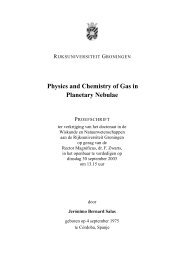TRACING ABUNDANCES IN GALAXIES WITH THE SPITZER ...
TRACING ABUNDANCES IN GALAXIES WITH THE SPITZER ...
TRACING ABUNDANCES IN GALAXIES WITH THE SPITZER ...
Create successful ePaper yourself
Turn your PDF publications into a flip-book with our unique Google optimized e-Paper software.
dust is seen in the spectrum. We see lines from ions of H, Ar, Ne, S and O in<br />
the IR spectrum of IC 2448. Close-ups of the lines in the high resolution Spitzer<br />
IRS spectrum of IC 2448 are shown in Figure 2.2. High ionization lines of [O IV]<br />
(ionization potential IP = 55 eV) and [Ar V] (IP = 60 eV) are observed, but even<br />
higher ionization lines such as [Ne V] (IP = 97 eV) and [Mg V] (IP = 109 eV) are<br />
not observed, indicating that there is only a moderately hard radiation field. Low<br />
ionization lines that would come from the photodissociation region (PDR) such as<br />
[Ar II] (IP = 16 eV) and [Si II] (IP = 8 eV) are not observed. A complete list of the<br />
observed lines and their fluxes is given in Table 2.1. The highest flux lines in the<br />
SH module (10.51 µm[S IV] and 15.55 µm[Ne III]) have bumps on each side of them<br />
that are instrumental artifacts, possibly resulting from internal reflection in the SH<br />
module or an effect of photon-responsivity. The bumps are just visible in Figure<br />
2.2 for the [S IV] line. However, the bumps contain a negligible amount of flux –<br />
only ∼3% and ∼1% of the flux in the main [S IV] and [Ne III] lines respectively,<br />
and we did not include these small contributions in our line flux measurements.<br />
The line fluxes are measured interactively in SMART for each nod position by<br />
performing a linear fit to the continuum on both sides of the line and then fitting a<br />
gaussian to the line. The values of the average line fluxes from both nod positions<br />
are given in Table 2.1. We estimate uncertainties in the line fluxes in two ways.<br />
In the first method, we propagate the uncertainties in the gaussian fit to the line<br />
flux to determine the uncertainty on the average flux from both nod positions.<br />
In the second method, we use the standard deviation of the fluxes measured in<br />
the two nod positions to determine the uncertainty on the average flux from both<br />
nod positions. We then take the final uncertainty as the greater of these two<br />
uncertainties. Lines fluxes typically have uncertainties � 10%; lines with larger<br />
uncertainties (� 15% and � 30%) are marked in Table 2.1. We determine 3σ upper<br />
34













